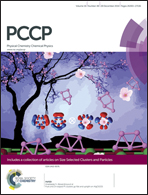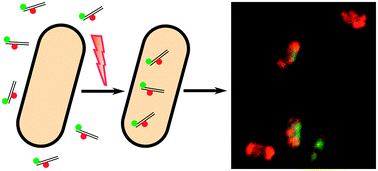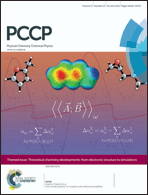 |
PCCP would like to introduce this week’s themed issue that explores theoretical chemistry, ranging from electronic structure theory to molecular dynamics simulations. ‘Theoretical chemistry developments: from electronic structure to simulations‘ aims to give an overview of developments in the field and give a voice to the younger researchers who are shaping the future through the development of theoretical tools that will dominate the field of quantum chemistry.
The guest editors of the issue are Barbara Kirchner (University of Bonn) and Frank Neese (Max-Planck Institute for Chemical Energy Conversion) and their editorial can be viewed for free untill 30th July 2015, along with this selection of articles: Simulations of room temperature ionic liquids: from polarizable to coarse-grained force fields, Mathieu Salanne, Phys. Chem. Chem. Phys., 2015,17, 14270-14279, DOI: 10.1039/C4CP05550K Towards an ab initio description of the optical spectra of light-harvesting antennae: application to the CP29 complex of photosystem II, Sandro Jurinovich, Lucas Viani, Ingrid G. Prandi, Thomas Renger and Benedetta Mennucci, Phys. Chem. Chem. Phys., 2015,17, 14405-14416, DOI: 10.1039/C4CP05647G How simple is too simple? Computational perspective on importance of second-shell environment for metal-ion selectivity, Ondrej Gutten and Lubomír Rulíšek, Phys. Chem. Chem. Phys., 2015,17, 14393-14404, DOI: 10.1039/C4CP04876H |
Archive for the ‘Themed Issue’ Category
Theoretical chemistry developments: from electronic structure to simulations
Size selected clusters and particles: from physical chemistry and chemical physics to catalysis – PCCP themed issue online now
PCCP is delighted to present its latest themed collection which includes a great selection of articles on Size selected clusters and particles. The issue was guest-edited by Jeroen van Bokhoven (Institute for Chemical and Bioengineering ETH Zurich) and Stefan Vajda (Argonne National Laboratory) and you can read an introduction to this issue in their editorial.
The outside front cover features an article from Anastassia N. Alexandrova et al. entitled Pure and Zn-doped Pt clusters go flat and upright on MgO(100).
There are many other great contributions to this themed issue including:
Optimised photocatalytic hydrogen production using core–shell AuPd promoters with controlled shell thickness
W. Jones, R. Su, P. P. Wells, Y. Shen, N. Dimitratos, M. Bowker, D. Morgan, B. B. Iversen, A. Chutia, F. Besenbacher and G. Hutchings
Phys. Chem. Chem. Phys., 2014,16, 26638-2664
Propene epoxidation with O2 or H2–O2 mixtures over silver catalysts: theoretical insights into the role of the particle size
M. Boronat, A. Pulido, P. Concepción and A. Corma
Phys. Chem. Chem. Phys., 2014,16, 26600-26612
Make sure to take a look at the full contents of this themed collection online now!
Charge generation mechanism in organic solar cells – PCCP themed issue online now
PCCP is delighted to present its latest themed collection which includes an excellent selection of interesting and timely articles on charge generation mechanism in organic solar cells. The issue was guest-edited by Maria Antonietta Loi and Alessandro Troisi and you can read their editorial to find out more.
The outside front cover features a Perspective article entitled Charge separation energies at organic heterojunctions: on the role of structural and electrostatic disorder from Frédéric Castet, David 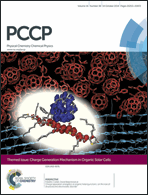 Beljonne et al.
Beljonne et al.
There are plenty of other great contributions in this themed collection, including:
Charge generation in polymer–fullerene bulk-heterojunction solar cells
Feng Gao and Olle Inganäs
Perspective, DOI: 10.1039/C4CP01814A
Ultrafast charge separation and nongeminate electron–hole recombination in organic photovoltaics
Samuel L. Smith and Alex W. Chin
Communication, DOI: 10.1039/C4CP01791A
Make sure to check out the full contents of the themed issue online now.
Density Functional Theory and its applications – themed collection online now!
PCCP is delighted to present its latest themed collection covering recent developments in Density Functional Theory with a balance between theory and applications. The issue was guest edited by David Tozer (Durham University, UK) and Michael Peach (Lancaster University, UK) and was published in conjunction with the 15th International Conference on Density Functional Theory and its Applications (DFT2013) that took place at Durham University, UK, from 9–13 September 2013.
The outside front cover features Dye Chemistry with time-dependent density functional theory, a perspective article from Adèle Laurent, Carlo Adamo and Denis Jacquemin.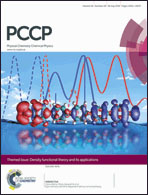
Check out the themed issue online which contains an excellent range of Papers and Communications in addition to the following Perspective articles:
One-electron self-interaction and the asymptotics of the Kohn–Sham potential: an impaired relation
Tobias Schmidt, Eli Kraisler, Leeor Kronik and Stephan Kümmel
Perspective, DOI: 10.1039/C3CP55433C
Density functional tight binding: values of semi-empirical methods in an ab initio era
Qiang Cui and Marcus Elstner
Perspective, DOI: 10.1039/C4CP00908H
The derivative discontinuity of the exchange–correlation functional
Paula Mori-Sánchez and Aron J. Cohen
Perspective, DOI: 10.1039/C4CP01170H
Measuring single-molecules in the living cell mini-collection online now!
A mini-collection of articles covering the newest developments in in vivo single-molecule methods has recently been published online as part of issue 25 of PCCP. The mini-collection highlights the great progress that has been made in tracking individual fluorescent proteins in living cells or bacteria and to this end the novel microscopy and labelling strategies that have been developed. Also covered are techniques like optical tweezers that are being applied more and more to living cells, using particles that are smaller and can be trapped with specificity.
The following articles are featured in the collection:
- A review by Lene Oddershede and co-workers detailing the recent and exciting results achieved through the optical force manipulation of individual molecules in vivo. The review describes the capabilities of optical tweezers, the only nano tool able to manipulate individual molecules and organelles within living cells without disturbing the cell wall. Read more about this extremely useful technique online.
- A perspective article by Erwin Peterman et al. reviews methods for investigating membrane–protein diffusion in bacteria, a challenging task due to the extremely small size of bactiera. This article has also been featured on the rather striking front cover of the issue!
- Mark Leake has contributed a perspective article detailing the development and application of a variety analytical methods used to localize and track single fluorescently-labelled molecules. He carefully evaluates known methods using case studies and identifies the challenges still facing the field in developing further robust analytical protocols to single-cell single molecule data.
- Anne Plochowietz and co-workers offer a new approach to study intramolecular charges or complex formation using FRET at the single-cell level in live bacteria. Read more online about how their method shows improved cell viability and loading over previous studies.
So read more about this fascinating area of research in issue 25 of PCCP online now!
Porous materials with FEZA 2014 – extended deadline
The deadline for submission to a cross journal web collection on porous materials in conjunction with the FEZA 2014 conference has been extended to 9th June 2014.
The conference will cover all aspects of science and technology associated with ordered porous materials – zeolites, zeotypes, mesostructured materials and porous coordination polymers. Submissions are welcome to the relevant journals across the themes of the conference and the collection will also receive promotion at the meeting in September.
For more information on the collection and participating journals, please see the original post.
The free energy landscape: from folding to cellular function – PCCP themed collection, Issue 14
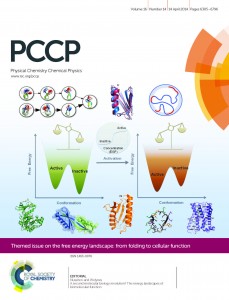 PCCP is delighted to present its latest themed issue collection which includes an excellent selection of articles on the free energy landscape: from folding to cellular function, guest edited by Ruth Nussinov and Peter Wolynes. Read their Editorial to find out more.
PCCP is delighted to present its latest themed issue collection which includes an excellent selection of articles on the free energy landscape: from folding to cellular function, guest edited by Ruth Nussinov and Peter Wolynes. Read their Editorial to find out more.
The free energy landscape: from folding to cellular function themed collection features a broad range of Papers and Communications and features the following Perspective articles:
The binding mechanisms of intrinsically disordered proteins
Jakob Dogan, Stefano Gianni and Per Jemth
The free energy landscape in translational science: how can somatic mutations result in constitutive oncogenic activation?
Chung-Jung Tsai and Ruth Nussinov
Protein conformation as a regulator of cell–matrix adhesion
Vesa P. Hytönen and Bernhard Wehrle-Haller
Astrochemistry – PCCP themed collection, Issue 8
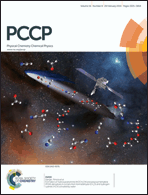
The outside front cover features Formation of hydroxyacetonitrile (HOCH2CN) and polyoxymethylene (POM)-derivatives in comets from formaldehyde (CH2O) and hydrogen cyanide (HCN) activated by water by Grégoire Danger, Albert Rimola, Ninette Abou Mrad, Fabrice Duvernay, Gaël Roussin, Patrice Theule and Thierry Chiavassa
The Astrochemistry themed collection features a broad range of Papers and Communications and features the following Perspective article:
Three milieux for interstellar chemistry: gas, dust, and ice
Eric Herbst
Phys. Chem. Chem. Phys., 2014, 16, 3344
DOI:10.1039/C3CP54065K
High performance computing in the chemistry of materials collection
PCCP themed collection: High performance computing in the chemistry of materials
Guest Editors: Richard Catlow and Scott Woodley (University College London)
PCCP is delighted to announce the high-profile themed web collection on ‘High performance computing in the chemistry of materials’. It is our pleasure to invite submissions for this collection.
Accepted articles will be published in Physical Chemistry Chemical Physics (PCCP) as and when they are ready, with a web collection prepared in 2014.
Deadline for Submissions: 17th March 2014
The applications of high performance computing (HPC) now play a major role in almost all areas of chemistry, but they are particularly effective in the field of materials chemistry. HPC is now being used in an increasingly predictive manner in modelling the structures (both surface and bulk), properties and reactivity of materials; and modelling techniques are now widely used in a complementary manner with experiments.
The collection will highlight the current state-of-the-art in the field by focussing on the following applications areas:
- Energy materials
- Surface Structures and properties
- Reactivity and catalysis
- Nano- and defect Chemistry
- Biomaterials
- Electronic materials
- Soft Matter and porous materials
Manuscripts can be submitted in any reasonable format using our online submissions service. Submissions should be high quality manuscripts and will be subject to rigorous peer review. Please indicate upon submission that your manuscript is intended for this themed collection.
The deadline for submissions to the collection is 17th March 2014, though submissions before this date are of course welcomed.
PCCP themed issue: Organic Field Effect Transistors
PCCP themed issue: Organic Field Effect Transistors
Guest Editors: Zhenan Bao (Stanford University), Antonio Facchetti (Northwestern University), Wenping Hu (Chinese Academy of Sciences), K. Krishnamoorthy (CSIR-National Chemical Laboratory-Pune)
PCCP is delighted to announce a high-profile themed issue ‘Organic Field Effect Transistors’. It is our pleasure to invite you to submit an original research article for this themed issue.
Deadline for Submissions: 2nd June 2014
The promise of low cost and flexible transistors has encouraged research groups to explore many avenues and resulted in organic field effect transistors (OFETs) with device efficiencies comparable to amorphous silicon based devices. Nonetheless many questions remain about various aspects of underlying physical chemistry of such devices:
- The vast majority of research on OFETs has focused on developing the semiconductors, with relatively little effort devoted to identifying a dielectric that would also ameliorate the device efficiency. The interaction between the semiconductor and the dielectric is crucial, yet it remained unexplored until very recently.
- Additional insight into the interaction between the radicals of the semiconductor with the dielectric could lead to fabrication of OFETs with low operating voltages which would be better suited to large scale commercialisation.
- A few initial reports show that limited doping can have a positive impact on device performance. Understanding the magnitude of doping and the concurrent band edge modulation would be useful to fabricate highly efficient OFETs.
- The exploration of electrolytes to identify the nature of ions required as the dielectric and its diffusion could open a new area of research.
- Flurocarbon containing semiconductor based OFETs have been widely demonstrated to be n-type transistors: understanding the underlying mechanism for this phenomenon could lead to new and exciting developments in the field.
This themed issue in PCCP aims to provide new physical chemistry insights into these and other questions, providing a better understanding of how and why current devices function. Such knowledge and understanding will be essential in the quest to further enhance the efficiency of OFETs.
Further information:
- Manuscripts can be submitted in any reasonable format using our online submissions service.
- Submissions should be high quality manuscripts and will be subject to rigorous peer review.
- Please indicate upon submission that your manuscript is intended for this themed issue.
- The deadline for submissions to the themed issue is the 2nd June 2014, although submissions before this date are of course welcomed.
- Accepted papers will be published online as soon as they are ready, to avoid any delay.











